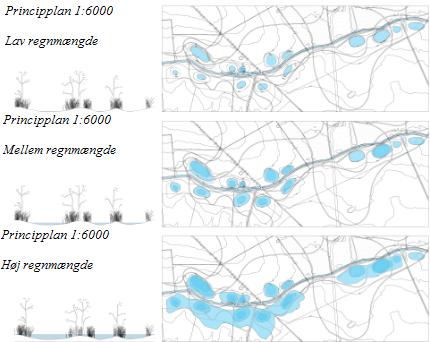In Odense, the third largest city in Denmark, climate change adaptation has had its say in the building of the new University Hospital. The hospital grounds will be designed to cope with extreme rainfall whilst not contributing to flooding elsewhere.
In the next five to eight years, a new hospital, Odense University Hospital and a research park will be constructed under the auspices of the University of Southern Denmark. The municipality of Odense has prepared an environmental plan for the area in order to assure public interests of the proper consideration of biodiversity and sustainable rainwater management. The plan is a so-called blue/green plan and includes a policy of a zero contribution of rainwater to the sewers from the curtilage of the buildings.
“It is easier to control rainwater in a newly built area compared to one in which existing an sewerage system imposes limitations,” says Charlotte Moosdorf,of Odense municipality.
“Our idea was to achieve the best solutions and the lowest costs possible by taking source control into account early in the process. Fortunately it was possible to present the plans before publication of the contract documents so that potential tenderers would know what we wanted. ”

Killerup brook is central to rainwater control in the area. The illustrations on the right show examples of rainwater control for the site in Odense. The top right illustration shows the current profile with steep banks. Below right shows the planned profile of a shallower swale with more gently sloping sides. The resulting landscape will create new wetlands adjacent to the swale which will function as a balancing zone for changing rain intensity. In addition, the area will have recreational value.
The blue-green plan does not dictate every technical detail but proposes a vision. In terms of rainwater, the plan states that everything has to be managed within the area and should not cause excessive direct rainwater contribution to the sewers. Moosdorf acknowledges the fact that some rainwater might be directed to sewers when the building is done:
“We should not be so rigid as to leave the contractor with no options. The recipient area is nonetheless a Natura 2000 site, so no solution can be allowed to damage the environment.”

Vegetation has to be robust in order to survive fluctuating water levels in the new wetlands. The illustration on the right shows the extent to which the wetland will change. In periods with low precipitation the area will be nearly dry, whereas there will be small and large ponds in periods of medium precipitation and lastly, under high precipitation, a series of small shallow lakes.
In principle the project will not be more expensive as a result of addressing climate change adaptation, believes Moosdorf:
“The technical solutions are not exactly rocket science and international practice provides a framework of examples. It is really about thinking in new ways. The rainwater issue is different from other things in that it extends across the cadastral map. It is all about considering land in bands stretching throughout the landscape. “
The new Odense University Hospital is expected to be ready in 2018.